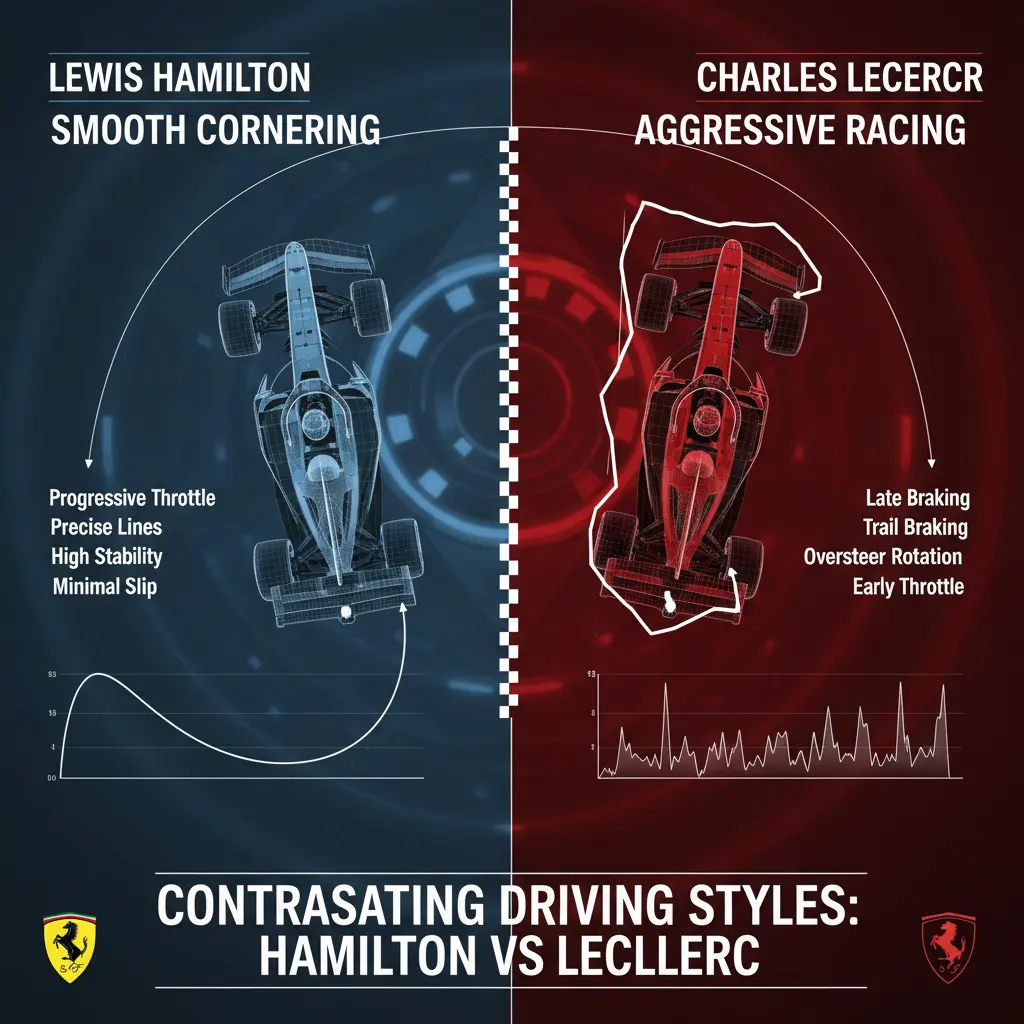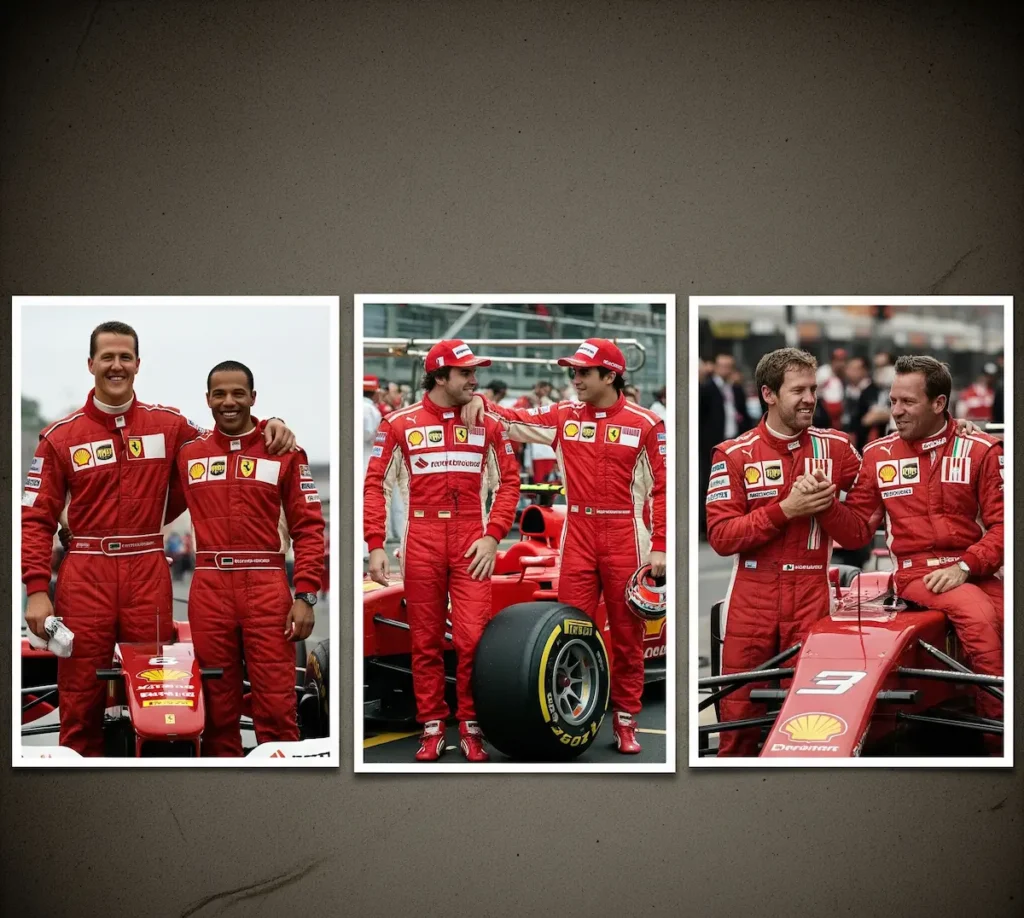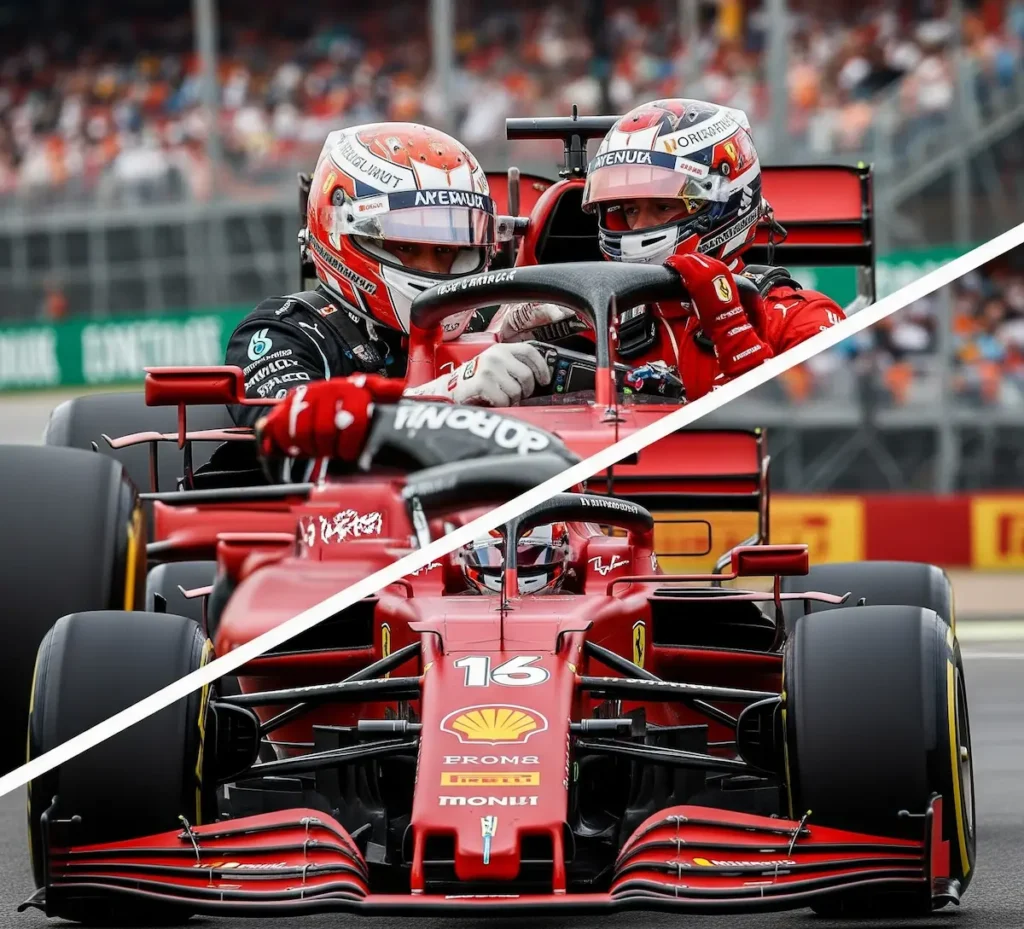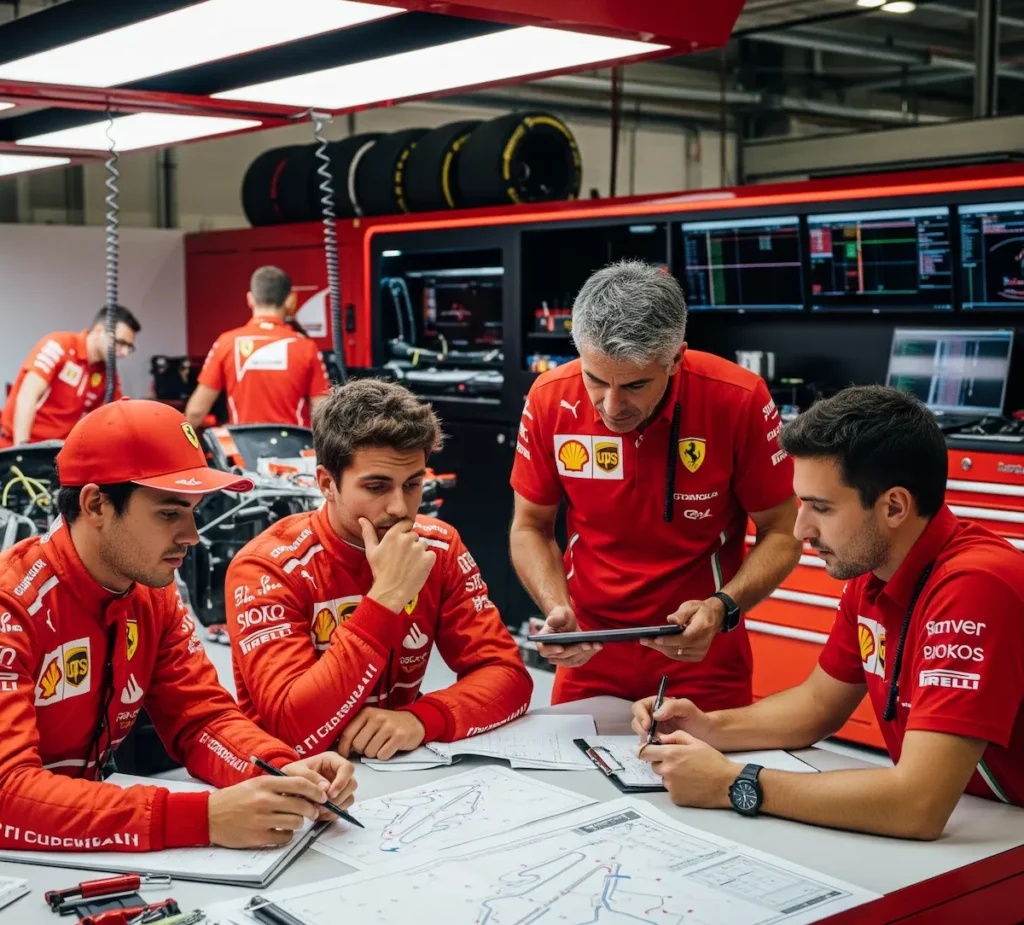Introduction: Lewis Hamilton Ferrari Swap 2025
Formula 1 has always been about more than racing. Beyond the roaring engines, blistering lap times, and nail-biting finishes, it’s the human drama that keeps fans glued to the sport. The 2025 season has already delivered one of the most shocking developments in recent history: Lewis Hamilton leaving Mercedes to join Ferrari.
The transfer itself was monumental, Hamilton, a seven-time World Champion and one of the greatest drivers in history, signing for Formula 1’s most iconic team. But what truly caught the world’s attention was Hamilton’s comment: “I will apologise to Charles.”
That one sentence shone a spotlight on Charles Leclerc, Ferrari’s long-time poster boy and future hope. Suddenly, the story wasn’t just about Hamilton’s bold career move, but about what it meant for Leclerc’s standing, Ferrari’s strategy, and the balance of power within the team.
This article will take you through the full story, covering the driver market context, Hamilton’s motivations, Leclerc’s position, the internal tensions, the apology, reactions across the F1 world, and what this means for Ferrari and Formula 1 as a whole.
1. Background to the Ferrari Driver Swap

The context of Formula 1’s driver market
The F1 driver market is a game of chess played years in advance. Contracts, buyout clauses, and whispers of negotiations constantly shift the balance. Teams want the best drivers, but only a few race seats are considered truly competitive. When a top driver moves, the ripple effect can reshape the grid for years.
Ferrari’s historical approach to star drivers
Ferrari has always believed in marquee names. Michael Schumacher’s arrival in the mid-1990s transformed the Scuderia into a dynasty. Later, Alonso and Vettel were signed with hopes of replicating that success. For Ferrari, investing in proven champions has been a recurring theme, even if it sometimes led to clashes with existing talent.
How Hamilton’s move to Ferrari unfolded
Hamilton’s move wasn’t just a quick negotiation. Behind the scenes, talks reportedly stretched over months, with Ferrari’s leadership, especially team principal Fred Vasseur, pushing hard to secure the Briton. For Hamilton, it was a chance to pursue one of the few dreams left in his legendary career: winning with Ferrari.
2. Lewis Hamilton’s Switch to Ferrari
The timing of the announcement
The announcement came earlier than expected, before the 2025 season officially began. This timing gave Ferrari momentum, but it also intensified speculation about Leclerc’s reaction and Mercedes’ next steps.
Hamilton’s motivations for leaving Mercedes
Hamilton’s move was fueled by several factors:
- Frustration with Mercedes’ performance since the dominance of 2014–2021 faded.
- The lure of Ferrari’s legacy, with Hamilton often mentioning that racing in red is a childhood dream.
- A final challenge, to prove he can win outside of Mercedes’ dynasty and secure an unmatched legacy.
Ferrari’s reasoning behind signing Hamilton
From Ferrari’s perspective, Hamilton brings more than driving skill:
- His technical expertise can accelerate car development.
- His global star power boosts Ferrari’s brand appeal.
- His winning mentality raises standards across the team.
Reactions from the paddock and fans
The reaction was seismic. Many applauded the boldness of the move. Others feared a repeat of past “two-star-driver” clashes. Fans lit up social media with debates: dream team or disaster waiting to happen?
3. Charles Leclerc’s Position at Ferrari
Leclerc’s current contract and commitment to Ferrari
Leclerc signed a long-term contract extension, believed to tie him to Ferrari until the late 2020s. This deal reflected his faith in Ferrari’s long-term vision.
His role as Ferrari’s lead driver before the swap
Until Hamilton’s signing, Leclerc was Ferrari’s undisputed No.1. He was the driver Ferrari built strategies around, the face of their campaigns, and their long-term bet for a championship.
Leclerc’s ambitions for a championship
Leclerc’s ultimate goal is clear: becoming Ferrari’s first driver’s champion since Kimi Räikkönen in 2007. He has the raw speed and determination, but has often lacked the machinery to compete consistently with Red Bull and Mercedes.
The emotional weight of Ferrari loyalty for Leclerc
Leclerc’s connection to Ferrari is deeply personal. A childhood fan of the Scuderia, he carries the emotional weight of driving for the team he once idolized. For him, Ferrari isn’t just an employer, it’s a dream realized. That makes Hamilton’s arrival both exciting and bittersweet.
4. The Swap Fiasco Explained

How negotiations created internal tensions
While Ferrari finalized Hamilton’s deal, Leclerc was reportedly not fully looped in on the details. This created tension, not necessarily hostility, but uncertainty about his role in the team’s future.
Miscommunication between management and drivers
The secrecy Ferrari maintained fueled media speculation. To fans, it looked as if Ferrari blindsided Leclerc. In reality, the team simply prioritized securing Hamilton before addressing internal optics.
Why is the situation being called a “fiasco”
The “fiasco” label comes from the messy communication and timing, not the move itself. Ferrari’s poor handling of messaging gave the impression of instability within the camp.
Media narratives vs behind-the-scenes reality
The media framed it as a Hamilton vs. Leclerc story, but internally, Ferrari sees it as a partnership. Still, perception is powerful, and the press amplified every hint of tension.
5. Hamilton’s Apology to Leclerc
The exact words: “I will apologise to Charles”
Hamilton admitted that the way the transfer unfolded might have blindsided Leclerc. He promised to apologise personally, out of respect for the younger driver.
Hamilton’s history of sportsmanship and accountability
Hamilton has long been known for addressing conflicts directly, whether with teammates like Nico Rosberg or rivals like Max Verstappen. His willingness to apologise fits his reputation for sportsmanship.
How the apology affects public perception
This gesture softened the narrative. Instead of being framed as an alpha driver barging in, Hamilton positioned himself as a respectful partner. Fans and pundits viewed it as a classy move.
Was the apology necessary or symbolic?
It wasn’t necessary; Leclerc is a professional who understands the business side of F1. But it was symbolic, showing Hamilton’s awareness of the emotional weight Leclerc carries at Ferrari.
6. Reactions Across the F1 World
Charles Leclerc’s response to Hamilton’s statement
Leclerc responded calmly, welcoming Hamilton and emphasizing teamwork. His reaction reflected maturity and focus on Ferrari’s greater goal.
Ferrari team principal’s perspective
Fred Vasseur framed the partnership as “two champions united for Ferrari.” His focus was on unity, making it clear that both drivers would be vital to the team’s 2025 plans.
Other drivers’ views on the swap
Some drivers praised Hamilton’s bold move, while others hinted at the challenges Ferrari might face. The consensus: Ferrari just became the most fascinating team to watch.
Fans’ divided opinions across social media
Fans split into camps; some saw a dream pairing that could finally dethrone Red Bull, while others worried about fireworks between two competitive personalities.
7. The Dynamics of Having Two Star Drivers

Historical precedents at Ferrari
Ferrari has dealt with this before:
- Schumacher–Barrichello (clear hierarchy).
- Alonso–Massa (tense but controlled).
- Vettel–Raikkonen (mutual respect).
The outcomes varied, but history shows Ferrari struggles when two alphas clash.
The challenges of driver hierarchy in F1 teams
Every F1 team, even those claiming equality, eventually leans toward one driver. Deciding between Hamilton and Leclerc will be one of Ferrari’s biggest challenges.
Possible scenarios for Hamilton-Leclerc coexistence
- Scenario 1: Healthy rivalry that pushes both drivers forward.
- Scenario 2: Clashes leading to lost points and damaged morale.
- Scenario 3: Natural hierarchy forms based on results.
How Ferrari might manage internal rivalry
Ferrari will need strong leadership, transparent communication, and strict rules of engagement. Clear boundaries will prevent on-track battles from spiraling into chaos.
8. Implications for Ferrari’s 2025 Season
Potential performance boosts from Hamilton’s arrival
Hamilton’s technical input could be the missing ingredient Ferrari needs to challenge Red Bull. His experience fine-tuning cars is invaluable.
Risks of destabilizing team chemistry
The flip side: two stars fighting for supremacy could cost Ferrari race wins and championships, repeating mistakes of the past.
Technical challenges and car development priorities
Ferrari must design a car that suits both driving styles. Hamilton prefers precision and smooth handling; Leclerc thrives on aggressive setups. Balancing both is tricky.
Ferrari’s long-term strategy with Hamilton and Leclerc
In the short term, Ferrari bets on Hamilton’s winning pedigree. Long-term, Leclerc remains the cornerstone. Managing this dual timeline is critical.
9. Broader Impact on Formula 1

How the swap reshapes the driver market
Hamilton’s move triggered a chain reaction. Other drivers and teams must now reassess contracts, sponsorships, and future strategies.
Implications for Mercedes post-Hamilton
Mercedes loses its talisman. George Russell becomes the new leader, but finding a partner who can fill Hamilton’s shoes won’t be easy.
Rival teams’ strategic responses
Red Bull, McLaren, and Aston Martin now see Ferrari as a bigger threat. Expect more aggressive moves in car development and driver strategies.
What this means for the sport’s global narrative
Hamilton joining Ferrari is a blockbuster story. It elevates F1’s profile globally, drawing in new fans intrigued by the clash of legacies and rivalries.
10. Media and Public Relations Perspective
How the press framed Hamilton’s apology
Headlines emphasized Hamilton’s humility, contrasting it with Ferrari’s secrecy. It made the apology a bigger talking point than the transfer itself.
Managing Ferrari’s image in light of the swap
Ferrari’s PR team worked overtime to present the signing as a harmonious partnership, but skeptics pointed out the risks of favoritism.
Social media amplification of the drama
On platforms like X, Instagram, and TikTok, Hamilton’s quote went viral. Fans dissected every word, creating endless debates and memes.
Lessons in crisis communication for sports organizations
The saga shows the importance of transparency, empathy, and timing. Even successful deals can backfire if communication isn’t managed well.
Conclusion
Lewis Hamilton’s Ferrari switch isn’t just another transfer; it’s a turning point in Formula 1 history. His decision to apologise to Charles Leclerc highlights the fine balance between respect, rivalry, and responsibility in elite sport.
Ferrari now faces both its greatest opportunity and its greatest challenge in decades. With Hamilton’s experience and Leclerc’s hunger, the Scuderia could finally break its championship drought. But only if unity prevails over rivalry.
As 2025 approaches, one thing is certain: the Ferrari garage will be the most fascinating place in Formula 1.
FAQs
Q1: Why did Lewis Hamilton say he would apologise to Charles Leclerc?
Lewis Hamilton acknowledged that his move to Ferrari might have caught Charles Leclerc off guard. The apology reflects his respect for Leclerc, who has been the team’s lead driver and a key figure at Ferrari for several years.
Q2: How did Charles Leclerc react to Hamilton joining Ferrari?
Leclerc responded professionally and diplomatically, welcoming Hamilton while reaffirming his commitment to Ferrari and the team’s championship goals.
Q3: What challenges does Ferrari face with two star drivers?
Ferrari now has to manage egos, prevent internal rivalry, and develop a car that suits both Hamilton’s smooth driving style and Leclerc’s aggressive approach. Clear team strategies and communication will be crucial.
Q4: How will Hamilton’s move affect Mercedes’ future?
Mercedes enters a transition phase. George Russell will likely become the team’s lead driver, and the team will need to find a new partner for him while adjusting development strategies post-Hamilton.
Q5: Could Hamilton and Leclerc’s partnership bring Ferrari a championship?
Yes, if Ferrari balances driver dynamics and delivers a competitive car. Hamilton’s experience, combined with Leclerc’s hunger and familiarity with the team, could finally end Ferrari’s drivers’ championship drought.
Q6: What is the impact of Hamilton joining Ferrari on the F1 driver market?
Hamilton’s move triggers a ripple effect across the grid, affecting driver contracts, team strategies, and opening opportunities for emerging talents to fill vacant or reshuffled seats.
Q7: Has Ferrari ever managed two star drivers successfully before?
Yes, historically, Ferrari has managed pairings like Schumacher-Barrichello, Alonso-Massa, and Vettel-Raikkonen. Success depends on a clear hierarchy, team management, and the drivers’ ability to work together.
Q8: Why is Hamilton’s apology considered symbolic?
While not strictly necessary, the apology signals respect and awareness of Leclerc’s position in Ferrari. It helps maintain harmony and positive public perception amid a potentially tense team dynamic.
Q9: How are fans reacting to Hamilton joining Ferrari?
Fans are divided; some see a dream team capable of challenging Red Bull, while others worry about internal conflicts between two alpha drivers. Social media discussions have been extensive and passionate.
Q10: What are the risks for Ferrari with Hamilton and Leclerc in the same team?
The main risks are internal rivalry, destabilized team chemistry, and potential clashes on track that could cost valuable championship points if not carefully managed.